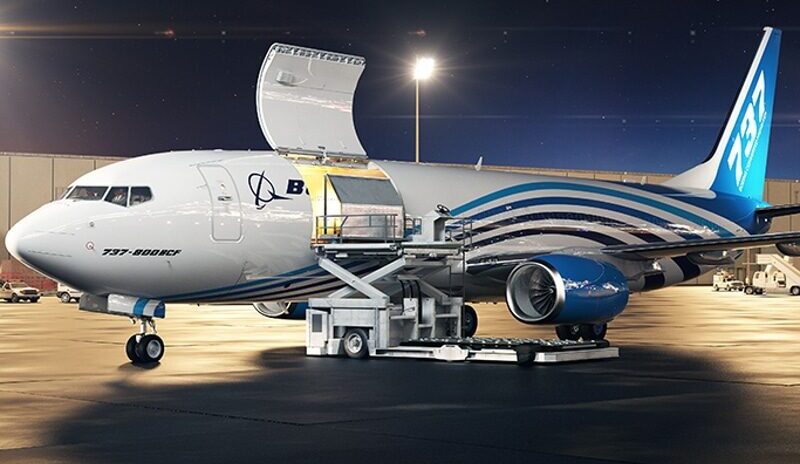Aerospace
How passenger aircraft converted into a freighter

The airplane, which is currently one of the fastest modes of transportation and has increased passenger demand, is only now starting to understand the importance of cargo transport. Airlines are looking for aircraft that can be converted from passenger to cargo flights. We will look at the conversion process in this article.
Passenger-to-Freighter (P2F) conversions allow passenger aircraft to be transformed into freighter aircraft. In order to enable the loading and unloading of goods, the process entails removing the seats and other passenger comforts from the aircraft’s cabin and replacing them with a cargo door and other alterations.
A well-liked and economical method of producing more cargo airplanes is to convert existing freighters. It’s amazing to observe how a passenger plane is transformed into a cargo, especially as airlines continue to acquire more and more of these jets. Here is an example of the entire process.
Here are the general steps involved in a typical P2F conversion:
- Removal of interior fittings: Interior fittings are removed from the aircraft, including the seats, galleys, restrooms, overhead bins, and other interior fittings.
- Reinforcement of the cabin floor: The installation of cargo handling systems includes the use of cargo nets, roller bed systems, and cargo loading systems.
- Installation of cargo handling systems: The cabin floor has been strengthened so that it can support the weight and loading demands of the cargo.
- Cargo door installation: To make it easier to load and unload cargo, a cargo door is mounted on the fuselage.
- Addition of structural modifications: Structural modifications may be required to support the added weight and stress of cargo operations.
- Cargo fire suppression systems and other avionics are installed to support cargo operations.
- Testing and certification: To make sure the modified aircraft complies with legal standards and is secure for cargo missions, it goes through rigorous testing and certification processes.
- Modifications: The P2F conversion process can be performed by specialized aircraft modification companies and can take several months to complete. The cost of the conversion varies depending on the type of aircraft and the extent of modifications required.
Specialized aircraft modification companies can carry out the P2F conversion process, which normally takes many months to complete. Depending on the type of aircraft and the amount of changes required the cost of conversion varies. However, by enabling operators to transport cargo, the change can increase the aircraft’s useful life and generate additional revenue.
Analysts predict that demand will increase in this sector based on the existing market. The modifications will also be advantageous for airlines, leasing firms, maintenance businesses, and aircraft manufacturers. A conversion of an aircraft is technically highly challenging. In order to assure efficient production and on-time completion, it necessitates highly skilled experts and a sizable quantity of parts. Many work steps used to be done manually, but today, even in the aviation sector, an increasing number of MRO (maintenance, repair, and operation) activities are being automated.

Aerospace
Boeing Transfers Rocket Stage to NASA, Paving Way for Human Moon Mission

Boeing has achieved a significant milestone by providing NASA with the second core stage of the Space Launch System (SLS) rocket.
This crucial component, crafted at NASA’s Michoud Assembly Facility (MAF), is set to propel the Artemis II crew into lunar orbit, marking humanity’s return to deep space after a 50-year hiatus.
The monumental Boeing-built rocket stage, the largest element of the Artemis II mission, will embark on a journey aboard the Pegasus barge, traveling 900 miles to NASA’s Kennedy Space Center.
Comparison of two legendary aircraft B777x vs B747 aircraft:Click here
Upon arrival, it will be meticulously integrated with other essential Artemis II components, including the upper stage, solid rocket boosters, and NASA’s Orion spacecraft within the iconic Vehicle Assembly Building. This intricate integration process is a vital step toward the eagerly anticipated Artemis II launch, slated for 2025.
“Boeing-built products helped land humankind on the moon in 1969, and we’re proud to continue that legacy through the Artemis generation,” remarked Dave Dutcher, vice president and program manager for Boeing’s SLS program. “Together, with NASA and our industry partners and suppliers, we are building the world’s most capable rocket and paving the way to deep space through America’s rocket factory in New Orleans.”
NASA, Lockheed Martin Reveal X-59 Quiet Supersonic Aircraft:Click here
The delivery of Core Stage 2 marks a significant achievement in the evolution of the SLS rocket. Towering over 200 feet and powered by four RS-25 engines, this core stage, coupled with two solid-fueled booster rockets, will generate a staggering 8.8 million pounds of thrust. This immense power is crucial to launching Artemis II and future missions into the vast expanse of space.
The SLS rocket stands unparalleled in its capability to transport both crew and substantial cargo to the moon and beyond in a single launch. Its extraordinary capacity will facilitate the delivery of human-rated spacecraft, habitats, and scientific missions to destinations including the moon and Mars, ushering in a new era of space exploration.
-

 Travel1 week ago
Travel1 week agoAir India to Expand US Operations with Three New Routes After a Decade
-

 Travel2 weeks ago
Travel2 weeks agoWhy We Should Avoid These Stamps in a Passport
-

 Airlines1 month ago
Airlines1 month agoInvestigations Reveal Fake Chinese Titanium in Boeing and Airbus Jets
-

 Tech4 weeks ago
Tech4 weeks agoChina’s CATL Plans 1,800-Mile Electric Plane Launch by 2027
-

 Airport3 days ago
Airport3 days agoTop 10 Largest Airports in the World by Size
-

 Aerospace4 weeks ago
Aerospace4 weeks agoChina’s Fighter Jets Turn Wings into Autonomous Drones
-

 Airlines4 days ago
Airlines4 days agoAir India Rolls Out A350s for Delhi-New York JFK and Newark Routes
-

 Defence3 weeks ago
Defence3 weeks agoBoeing Enhances Chinook with New Engines and Block II Upgrades at $96 Million







